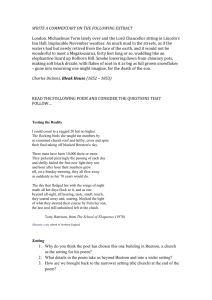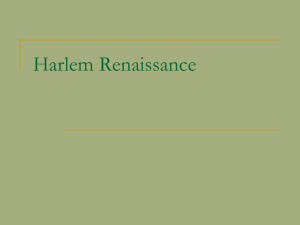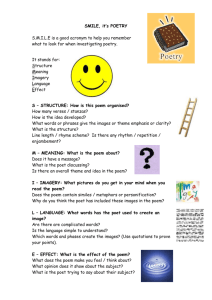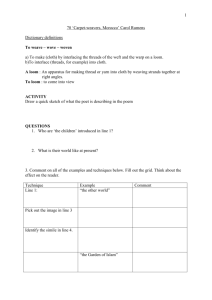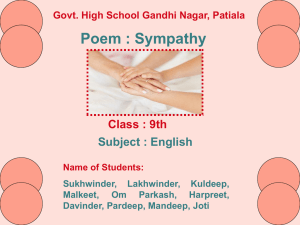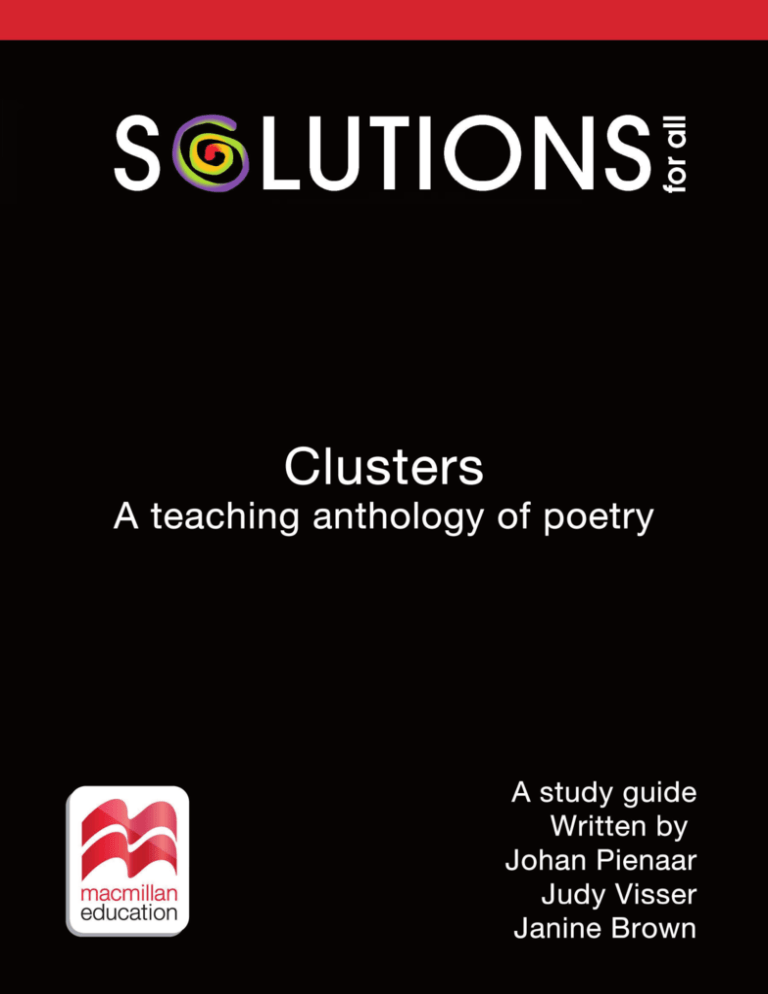
Clusters: A teaching anthology of poetry: A study guide © Design, text and illustrations Guidelines
(An imprint of Macmillan SA (Pty) Ltd), 2009
All rights reserved. No part of this publication may be reproduced, stored in
a retrieval system, or transmitted in any form or by any means, electronic,
photocopying, recording, or otherwise, without the prior written permission of
the copyright holder or in accordance with the provisions of the Copyright Act,
1978 (as amended). Any person who does any unauthorised act in relation to this
publication may be liable for criminal prosecution and civil claims for damages.
First published 2009
09 11 13 15 14 12 10
1 3 5 7 9 10 8 6 4 2 0
Published by Guidelines
An imprint of Macmillan South Africa (Pty) Ltd
Private Bag X19, Northlands, 2116
Tel: 011 731 3300
Fax: 011 731 3500
Email: info@guidelines.co.za
www.guidelines.co.za
Authors: Johan Pienaar, Judy Visser and Janine Brown
Editor: Judith Marsden
Typesetter: The Purple Turtle Publishing Services
ISBN 9781770175358
WIP 0444G000
It is illegal to photocopy any page of this book without written permission
from the publishers.
The publishers have made every effort to trace the copyright holders.
If we have inadvertently overlooked any, we will be pleased to make
the necessary arrangements at the first opportunity.
Clusters.indd 2
20/10/2009 08:13:22
Contents
Introduction..................................................................................................................................................................1
The prescribed poems for the exam............................................................................................................1
How to go about studying poetry...............................................................................................................1
How to use this study guide........................................................................................................................1
The poetry examination...............................................................................................................................2
Poetry analyses............................................................................................................................................................3
1. Constantly Risking Absurdity...............................................................................................................3
Lawrence Ferlinghetti
2. To the Public...........................................................................................................................................6
Louis Macneice
3. Love’s Farewell.......................................................................................................................................8
Michael Drayton
4. ‘To me, fair friend, you never can be old’.........................................................................................10
William Shakespeare
5. The Sun Rising......................................................................................................................................13
John Donne
6. Kubla Khan...........................................................................................................................................16
Samuel Taylor Coleridge
7. Ode to Autumn.....................................................................................................................................20
John Keats
8. Remembrance.......................................................................................................................................24
Emily Brontë
9. Refugee Blues.......................................................................................................................................26
W H Auden
10. The Horses............................................................................................................................................30
Ted Hughes
11. The Discardment..................................................................................................................................33
Alan Paton
12. Penguin on the Beach..........................................................................................................................35
Ruth Miller
13. Trespasser.............................................................................................................................................38
Tatumkhulu Afrika
14. Touch.....................................................................................................................................................42
Hugh Lewin
15. Lost or Found World............................................................................................................................45
Mongane Wally Serote
16. Release, February 1990.......................................................................................................................47
Lynne Bryer
17. Crossing over........................................................................................................................................51
Chris Mann
18. Strangers forever.................................................................................................................................54
Amin Kassam
19. West London.........................................................................................................................................57
Matthew Arnold
20. Mirror....................................................................................................................................................59
Sylvia Plath
21. Will it be so again?..............................................................................................................................63
Cecil Day-Lewis
Answers to the questions.........................................................................................................................................66
Clusters.indd 3
28/10/2009 16:09:01
Introduction
This Literature Guide covers the poetry prescribed by the Independent Examinations Board (IEB) for the
Grade 12 English Home Language National Senior Certificate Exam for 2010 and 2011. All the prescribed
poems are from an anthology called Clusters: a teaching anthology of poetry. These poems have been published
in other anthologies and their layout may differ among different publications. In this study guide, however,
the layout given in the prescribed text Clusters has been followed.
The prescribed poems for the exam
The prescribed poems for the exam cover many different topics. Each poem is a self-contained unit, which is
how each should be studied. There are comparisons you might like to make with other poems but, to begin,
try to understand what each poem has to say on its own, and how the poem is presented. You should consider
each poem on its own merit, thinking carefully about how the poet has chosen to share his or her ideas with
you. Since poets usually raise issues that are common to most people, you might form your own opinions
about what the poet has to say. This is good and will help you in the exam. However, always remember that
the poet has something specific and personal to share with the reader. You should always keep this in mind.
The prescribed poems vary from traditional poems by William Shakespeare to modern poems by Chris Mann.
The settings, places and contexts are all different and each poem has its own story to tell.
How to go about studying poetry
As with any literature, you should ask yourself the following question: “What is the poem about? What is
the story that the poem is telling?” We could call this the basic plot, the content or the narrative. Often there
might not be a clear story because the poet simply wants to share an emotion or a response to an event.
However, you should be able to sum up what the poem is telling the reader in a sentence or two.
The next step is to decide what the poet wants to tell the reader. Ask yourself: “What is the poet’s intention
in writing this poem? Why did the poet write the poem?” You could also think of the ‘intention’ as being
the main theme of the poem. This will help you to understand what the poet wants to share with the reader.
Once you have read a poem, complete the following sentence: The poet wrote the poem to describe/share/
tell/make clear … . There are many other words you could use. However, try to keep your answer short – one
or two sentences will do.
Now you are ready to look at how the poet has chosen to present his or her story, message or personal
thoughts. Ask the question: “How does the poet present the poem?” This means you have to look at the
structure of the poem, i.e. the way it is written. This includes:
the format (the way the poem is printed, i.e. the layout)
the language used
the imagery
the use of figures of speech
the rhyme and/or rhythm
anything else that helps the poet to communicate his or her special ‘message’ or ‘story’ to the reader.
There will be many different aspects to look at that will tell you more about the poet’s intention, ranging
from the type of poem (e.g. sonnet, ballad) to the individual way in which the poem is written. This is the
most interesting part of poetry study because it allows you to think about, make decisions and comment
personally on what you have read.
How to use this study guide
In the final examination you will be asked to comment on certain aspects of the poems you have studied. In
this guide you will find each poem discussed according to the following format:
Poet biography and background
You will be introduced to the poet and the times in which he or she wrote. You will also be given any
additional information that might be relevant to the poem or to why the poet wrote the poem at that
time. Think, for example, of the apartheid years and the Struggle poetry that emerged from this difficult
period in our country’s history. The poets were making a particular statement at a particular time in our
history and with a specific purpose: to shock, to make people aware, and to bring about change. Today we
consider these poems to be a vital part of our social and political history in a democratic South Africa.
Content
This will entail a short explanation of what the poem is about.
Introduction
Clusters.indd 1
20/10/2009 08:13:22
Poetry analyses
Constantly Risking Absurdity
Lawrence Ferlinghetti
Poet biography and background
Lawrence Ferlinghetti is a celebrated American poet who was born in New York in 1919. He belongs to a
movement termed ‘Postmodernism’ and is renowned for being one of the founders of a magazine entitled
City Lights as well as a bookstore in San Francisco that carries the same name.
Ferlinghetti is a poet, an activist and an essayist. He is included in a group of poets who came to be known as
the Beat New American poets. Among this poet’s important themes are the idea of perseverance, admiration
for human endeavour – no matter how small, and the absurdity of everyday life. His idea is that you can
conquer the conquerors of the world with words, which is an important concern in this poem.
Felinghetti also writes about the beauty of the natural world. He sees life as being both amusing and tragic.
As a poet, Ferlinghetti is concerned with the dilemma of the everyday individual making his or her way
through life. His poetry also tackles many political issues, such as the Vietnam War in the 1960s.
Content
In Constantly Risking Absurdity the poet focuses on one of his important themes: how to define art and
examine the artist’s role in modern society. Part of his message is that poetry should transport the public to
higher places than other wheels can carry it.
The poem is based on the comparison between a tightrope walker who constantly has to take chances and
defy “absurdity” or the ridiculous, and the poet who finds himself in a similar situation. They seem to share
a common occupation, both taking wild chances in order to succeed and to entertain the public. However,
both also have to consider the risk-taking factor. There is always the chance of failure. However, the public
– both audiences – must be contented, delighted and thrilled. There is “Beauty” but there is also danger, and
there is further truth in both performances and achievements.
The poet’s intention
In this poem Ferlinghetti sets out to highlight the highs and lows of writing poetry. It is a poem about
writing a poem, about creating art and poetry. The poet is at times both absurd and brave. He is bold – an
adventurer in search of “truth” as he moves forward in the pursuit of that elusive goal, “Beauty”.
For Ferlinghetti there are similarities in the “death-defying” feats of the acrobat – high above the heads of
the audience, constantly striving for balance while moving towards the other side of the tightrope – and the
poet. The attraction of the poem and the ingenuity of its extended image lies in the similarities the poet sees
in both actions and professions, and the way in which he is able to sustain the comparison. In the process,
Ferlinghetti makes the reader increasingly aware of the role of a poet.
Structure
A careful reading of the poem reveals that, although it seems to move in one continuous whole, without
punctuation or division into stanzas, there are in fact two major pauses noted by a capital letter in the text.
These occur at the beginning of line 19 and line 28.
This structure will be taken into account as we examine the poem.
Lines 1–18
The poem opens with the words quoted in the title. However, although the poet makes the point that the
tightrope walker really seems to be defying all rules of reason and logic by walking a distance, balanced only
on a rope and carrying his whole weight on a slender wire, he is also, in fact, defying “death”. A fall from
that height could be fatal. The feat is thus both ludicrous and brave. He performs this feat for the delight
of the audience seated far below. In the opening five lines, therefore, the poet creates a vivid picture of the
tightrope walker. Every time he tackles this challenge, he is taking a chance and risking his life to entertain
Poetry analyses
Clusters.indd 3
20/10/2009 08:13:22





